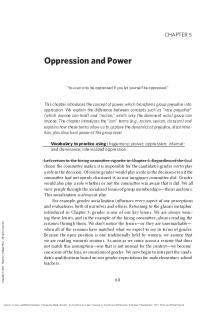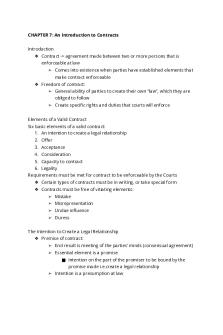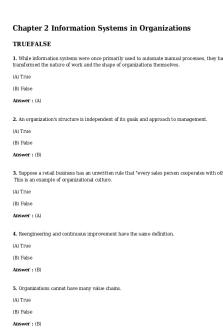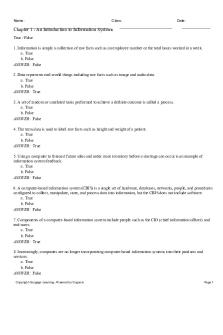Chapter 5 Is Everyone Really Equal An Introduction to Key Co PDF

| Title | Chapter 5 Is Everyone Really Equal An Introduction to Key Co |
|---|---|
| Author | Omar Al-jameel |
| Course | Working with Young Children in Inclusive Group Settings |
| Institution | Capilano University |
| Pages | 20 |
| File Size | 504.8 KB |
| File Type | |
| Total Downloads | 15 |
| Total Views | 139 |
Summary
Download Chapter 5 Is Everyone Really Equal An Introduction to Key Co PDF
Description
CHAPTER 5
Oppression and Power “You can only be oppressed if you let yourself be oppressed.”
This chapter introduces the concept of power, which transforms group prejudice into oppression. We explain the difference between concepts such as “race prejudice” (which anyone can hold) and “racism,” which only the dominant racial group can impose. The chapter introduces the “ism” terms (e.g., racism, sexism, classism) and explains how these terms allow us to capture the dynamics of prejudice, discrimination, plus structural power at the group level.
Copyright © 2017. Teachers College Press. All rights reserved.
Vocabulary to practice using: hegemony; power; oppression; internalized dominance; internalized oppression Let’s return to the hiring committee vignette in Chapter 4. Regardless of the final choice the committee makes, it is impossible for the candidate’s gender not to play a role in the decision. Of course gender would play a role in the decision even if the committee had not openly discussed it, as our imaginary committee did. Gender would also play a role whether or not the committee was aware that it did. We all view people through the socialized lenses of group memberships—theirs and ours. This socialization is always at play. For example, gender socialization influences every aspect of our perceptions and evaluations, both of ourselves and others. Returning to the glasses metaphor introduced in Chapter 3, gender is one of our key lenses. We are always wearing these lenses, and in the example of the hiring committee, always reading the resumes through them. We don’t notice the lenses—or they are unremarkable— when all of the resumes have matched what we expect to see in terms of gender. Because the open position is one traditionally held by women, we assume that we are reading women’s resumes. As soon as we come across a resume that does not match this assumption—one that is not normal for the context—we become conscious of the lens, or conscious of gender. We now begin to interpret the candidate’s qualifications based on our gender expectations for male elementary school teachers.
60
Sensoy Ozlem and Robin DiAngelo Is Everyone Really Equal? : An Introduction to Key Concepts in Social Justice Education Teachers College Press 2017 ProQuest Ebook Central
Oppression and Power
61
Again, this does not mean that we were not interpreting the other resumes from our expectations for females, but because our expectations matched the resumes of female candidates, we are not aware that we are doing this; our gender lens is invisible to us because seeing the resumes of female applicants for this position is normal. Gender becomes consciously relevant only when we come across a resume that does not match what we expect to see. If the candidate is not hired due to prejudice against him as a male, this will constitute discrimination but not oppression. However, if he is not hired because of prejudice against him based on an assumption that he is gay, this will constitute oppression. To put it another way, Mary (who is prejudiced against a gay candidate) is enacting oppression, but Liz (who is prejudiced against a male candidate) is not. Why? To understand, we must build on the concepts of prejudice and discrimination by adding an understanding of oppression and power. But before we begin this discussion, let’s revisit an important element of critical thinking introduced in Chapter 2. Our distinguishing between the results of Mary’s prejudice and Liz’s prejudice unsettles common ideas about fairness and will likely seem unfair to many people, at least initially. But we remind readers that the way we have been taught to think about these relationships hides their operation in society. In this book we are providing a critical theory framework that is different from the one mainstream socialization provides; a critical theory framework is based on solid scholarship, study, and practice.
Copyright © 2017. Teachers College Press. All rights reserved.
What Is Oppression? To oppress is to hold down—to press—and deny a social group full access and potential in a given society. Oppression describes a set of policies, practices, traditions, norms, definitions, and explanations (discourses), which function to systematically exploit one social group to the benefit of another social group. The group that benefits from this exploitation is termed the dominant (or agent) group, and the group that is exploited is termed the minoritized (or target) group. Oppression is different from prejudice and discrimination in that
Oppression: The prejudice and discrimination of one social group against another, backed by institutional power. Oppression occurs when one group is able to enforce its prejudice and discrimination throughout society because it controls the institutions. Oppression occurs at the group or macro level, and goes well beyond individuals. Sexism, racism, classism, ableism, and heterosexism are specific forms of oppression.
Sensoy Ozlem and Robin DiAngelo Is Everyone Really Equal? : An Introduction to Key Concepts in Social Justice Education Teachers College Press 2017 ProQuest Ebook Central
62
Is Everyone Really Equal?
prejudice and discrimination describe dynamics that occur on the individual level and in which all individuals participate. In contrast, oppression occurs when one group’s prejudice is backed by legal authority and historical, social and institutional power. Common shorthand within the discipline is:
Copyright © 2017. Teachers College Press. All rights reserved.
Prejudice > Discrimination Prejudice + Power = Oppression Oppression involves institutional control, ideological domination, and the imposition of the dominant group’s culture on the minoritized group. No individual member of the dominant group has to do anything specific to oppress a member of the minoritized group; the prejudice and discrimination is built into the society as a whole and becomes automatic, normalized and taken for granted. The example of women’s suffrage (gaining the right to vote) in the United States and Canada illustrates several distinguishing features of oppression. Women of course played a primary role in the struggle for suffrage; they had to organize and fight to gain the vote. Yet ultimately, the ability to grant women suffrage rested in the hands of men; women could not grant themselves the right to vote because they did not hold institutional power. Only men could actually grant suffrage to women because only men held the institutional positions of power necessary to do so. Hence, while both groups could be prejudiced against the other, men’s prejudice took on a much more powerful and all-encompassing form. Because men controlled all of the major institutions—government, media, economics, religion, medicine, education, police, and military—the collective effect of men’s prejudice was radically different. Men as a group infused their prejudice into the very fabric of society. Prejudice is often unconscious, so this would happen whether or not men intended to or were aware that they were doing this. Because men made the rules, the rules reflected their prejudices and served their interests. For example, because scientists began with the premise of female inferiority, their research questions and the interpretation of their findings were informed by that assumption (Harding, 1991; Tuana, 1993). Because they were in the position to disseminate their findings, they further reinforced and rationalized their superior positions. All other institutions (also controlled by men) were constructed in ways that normalized male superiority (Tuana, 1989): The clergy preached male superiority from the pulpit and rationalized it through the Bible; doctors used the male body as the reference point for health; psychiatrists based definitions of mental health on male norms for emotions and rationality; and male professors taught men’s history, ideas, and concerns. The term for male centrality is androcentrism. Androcentrism is not simply the idea that men are superior to women, but a deeper premise that supports this idea: the definition of males and male experience as the standard for human, and
Sensoy Ozlem and Robin DiAngelo Is Everyone Really Equal? : An Introduction to Key Concepts in Social Justice Education Teachers College Press 2017 ProQuest Ebook Central
Oppression and Power
63
females and female experience as a Androcentric: Male centered. deviation from that norm. Androcentrism remains invisiThe centering of society on the interests, needs, norms, patterns and ble in all contexts except when we are perspectives of men. specifically referring to women, for example: women’s literature, women’s movies (or “chick flicks”), women’s basketball, and women’s rights. “Men” (as a group) are the invisible reference point that women are measured against, and because women do not fit the norms of men, they appear inferior. In this way, male superiority is rationalized, normalized, disseminated, and reinforced through every social institution. Returning to our suffrage example, because oppression is one group’s prejudice plus the power to enforce that prejudice throughout society, even if individual men believed women should have the right to vote, as men they still benefited from women’s exclusion. Thus oppression need not be personal, and intentions are irrelevant in terms of having privilege and advantage.
Social Stratification In Chapter 3 we discussed how individuals belong to various social PERSPECTIVE CHECK: Figure groups. For the purposes of under5.1 is not intended to imply that these standing socialization, we described are the only forms of oppression in how important it is for individuals society. For example, we have not to recognize the significance of these included oppressions such as adultsocial groupings. For the purposes of ism, ageism, linguicism, or sizeism, understanding oppression, we must nor have we separated out the way also understand that these groups are that anti-Semitism is both a form of given different value in our society. religious oppression and also ethnic This process of assigning unequal valoppression. Our intention is not to ue is called social stratification. deny the reality of these forms of All major social group categories oppression but rather to provide a (such as gender) are organized into starting point for those new to the binary, either/or identities (e.g., men/ recognition of group membership women). These identities depend and social positionality. upon their dynamic relationship with one another, wherein each identity is defined by its opposite. The category “men” can have no meaning without an understanding of a category called “women.” Not only are these groups constructed as opposites, but they are also ranked into a hierarchy. This means that one group (men) is positioned as more valuable than its opposite (women). The group that is positioned as more valuable—the dominant group—will have more access to the
Copyright © 2017. Teachers College Press. All rights reserved.
Sensoy Ozlem and Robin DiAngelo Is Everyone Really Equal? : An Introduction to Key Concepts in Social Justice Education Teachers College Press 2017 ProQuest Ebook Central
64
Is Everyone Really Equal?
Figure 5.1. Group Identities Across Relations of Power
Minoritized/Target Group
Oppression
Dominant/ Agent Group
Peoples of Color Poor
Racism
White
Working Class
Classism
Owning Class
Sexism
(cis)Men
Heterosexism
Heterosexuals
Religious Oppression
Christians
Anti-Semitism Ableism Nationalism Colonialism
Able-bodied Citizens (perceived) White Settlers
Middle Class Women; Transgender; Genderqueer Gays; Lesbians; Bisexuals; Two Spirit Muslims; Buddhists; Jews; Hindus; and other non-Christian groups
Copyright © 2017. Teachers College Press. All rights reserved.
People with Disabilities Immigrants (perceived) Indigenous Peoples
resources of society. The group that is positioned as less valuable—the minoritized group—will have less access to the resources of society. The terms used to describe these relationships of inequality between dominant and minoritized groups usually ends in “ism.” Figure 5.1 illustrates the historical and current relationships between some of these key social groups in Canada and the United States and the term for that specific form of oppression. As you read down the table, you will probably find yourself in both dominant and minoritized group positions (i.e., falling sometimes on the left side and sometimes on the right side of the oppression column). One is not simply a man, but a cisgender man, a White man, or a man of Color; or a working-class White man, perhaps a working-class gay White man, or a heterosexual Christian able-bodied man of Color—and each of these identity positions intersect in important ways. In the case of women’s suffrage, we can see how these intersecting group identities add more layers of complexity. Women’s suffrage is a more complicated story when we add the dimensions of class and race. White women of the upper classes led the initial movement for women’s suffrage in both Canada and the United States (Davis, 1981; Devereux, 2005; Newman, 1999). In Canada, racial exclusion in suffrage was not removed until the 1940s and did not extend the right to vote freely to Indigenous peoples until the 1960s. In the United States, Black women did not have full access to the right to vote until the Voting Rights Act of 1965. So
Sensoy Ozlem and Robin DiAngelo Is Everyone Really Equal? : An Introduction to Key Concepts in Social Justice Education Teachers College Press 2017 ProQuest Ebook Central
Oppression and Power
65
Figure 5.2. Dolores Huerta (b. 1930) Huerta is a pioneering labor and civil rights leader, and the cofounder (with Cesar Chávez) of the United Farmworkers of America. In 1955 she became involved with a grassroots organization (the Community Service Organization) that was fighting police brutality in the community and pushing for improved public services. It was there at CSO that she met Cesar Chávez. Together they became involved in supporting farm workers, and she played a central role as cofounder, organizer, and leader for the movement. She led some of the most important peaceful demonstrations and public boycotts, spoke out against the harmful effects of pesticides, organized field strikes, and lobbied for changes to policies to support workers. All of her efforts helped win recognition for farm workers’ rights. She was also significantly involved in the feminist movement, and challenged gender discrimination within the farm workers movement. Today, the Dolores Huerta Foundation pursues its mandate to motivate and organize sustainable communities in order to attain social justice. Note. Photo available at https://feminismandreligion.com/2012/11/02/delores-huerta-si-se-puede/
while the women we commonly refer to as suffragists were oppressed as women, they were privileged as White women: Their race was made neutral and natural to the exclusion and marginalization of women of Color, as they were held up as representing all women. For example, one of the key issues of suffragists was entry into the workforce. But of course women of Color had long been working outside the home. Their interests may have been better served by calls for economic justice. The life and work of Dolores Huerta (Figure 5.2) embodies the concept of intersectionality.
Copyright © 2017. Teachers College Press. All rights reserved.
Understanding the “isms” In order to understand how oppression works and why it is different from discrimination, we must understand that oppression involves pervasive, historical, and political relationships of unequal power among social groups. It is more than an individual, situational, or momentary interaction. Scholars capture this largescale, historical, political, and pervasive relationship through the “ism” words, such as: racism, sexism, heterosexism, classism, ableism. In the study of social stratification, when scholars use the “ism” words, we are not referring primarily to individual acts of discrimination, which all people can commit. Rather, we are referring to specific forms of oppression.
Sensoy Ozlem and Robin DiAngelo Is Everyone Really Equal? : An Introduction to Key Concepts in Social Justice Education Teachers College Press 2017 ProQuest Ebook Central
66
Is Everyone Really Equal?
The “ism” words give us the language to discuss these specific forms STOP: Discrimination and the of oppression and include in the “isms” (e.g., sexism and racism) are discussion the reality of unequal sonot the same thing. All people have cial and institutional power between prejudice and discriminate, but only dominant and minoritized groups. the dominant group has the social, In this way, we avoid denying powhistorical, and institutional power er dynamics by reducing oppression to back their prejudice and infuse it to individual acts of discrimination throughout the entire society. Thus and claiming that these acts are comthese terms cannot be used interparable, regardless of who commits changeably. them. From this perspective, “reverse racism” or “reverse sexism” are misnomers and do not exist because racism and sexism (or any form of oppression) refer to power relations that are historic, embedded, and pervasive—they are not fluid and do not flip back and forth; the same groups who have historically held institutional power in the United States and Canada continue to do so. For example, despite suffrage and women’s numerical majority, in 2017 women in the United States are only 19% of the House and Senate seats, 33% of the Supreme Court, 18% of mayors, 8% of governors and have never held the highest office, the presidency. In Canada, women constitute 52% of the population, and in 2015 Canada’s new Prime Minister Justin Trudeau gained wide praise for appointing a 50/50 gender-balanced Cabinet. Despite this important move, women are still under-elected to federal posts, making up only 26% of members of parliament (MPs) in the House of Commons. Thus, many of the 24 standing House committees (such as Environment, Health, Industry Science and Technology, National Defence, Public Safety, Veterans Affairs) are without equal (even marginal) female MP representation simply because there aren’t enough elected women MPs to go around. These committees play important roles in the evaluation of legislation that’s before the House, and these committees make decisions that impact women’s lives (Taber, 2016; Equal Voice, 2014; Parliament of Canada, 2017). The only one of the 24 standing House committees with a female majority is the Status of Women committee (Taber, 2016). In 2015, across Canada women represented 28% of city councillors, and 18% of mayors (Federation of Canadian Municipalities, 2015). The United Nations has concluded that a critical mass of at least 30% of women is needed before government policies begin to reflect women’s priorities and shift governmental management style and organizational culture (Tarr-Whelan, 2009). In 2017 Canada and the United States were 62nd and 104th respectively in an international ranking of women’s representation in 193 federal parliaments (dropping from their positions as 50th and 72nd respectively in 2010) (Inter-Parliamentary Union, 2017). In fact, the number one country in terms of women holding office is Rwanda (with women holding 61% of seats); Sweden, Spain,
Copyright © 2017. Teachers College Press. All rights reserved.
Sensoy Ozlem and Robin DiAngelo Is Everyone Really Equal? ...
Similar Free PDFs

An introduction to Psychology
- 4 Pages

An introduction to sociolinguistics
- 451 Pages
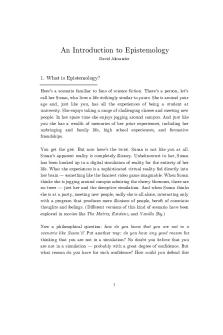
1. An Introduction to Epistemology
- 10 Pages

1. An Introduction to Glaciers
- 6 Pages
Popular Institutions
- Tinajero National High School - Annex
- Politeknik Caltex Riau
- Yokohama City University
- SGT University
- University of Al-Qadisiyah
- Divine Word College of Vigan
- Techniek College Rotterdam
- Universidade de Santiago
- Universiti Teknologi MARA Cawangan Johor Kampus Pasir Gudang
- Poltekkes Kemenkes Yogyakarta
- Baguio City National High School
- Colegio san marcos
- preparatoria uno
- Centro de Bachillerato Tecnológico Industrial y de Servicios No. 107
- Dalian Maritime University
- Quang Trung Secondary School
- Colegio Tecnológico en Informática
- Corporación Regional de Educación Superior
- Grupo CEDVA
- Dar Al Uloom University
- Centro de Estudios Preuniversitarios de la Universidad Nacional de Ingeniería
- 上智大学
- Aakash International School, Nuna Majara
- San Felipe Neri Catholic School
- Kang Chiao International School - New Taipei City
- Misamis Occidental National High School
- Institución Educativa Escuela Normal Juan Ladrilleros
- Kolehiyo ng Pantukan
- Batanes State College
- Instituto Continental
- Sekolah Menengah Kejuruan Kesehatan Kaltara (Tarakan)
- Colegio de La Inmaculada Concepcion - Cebu
